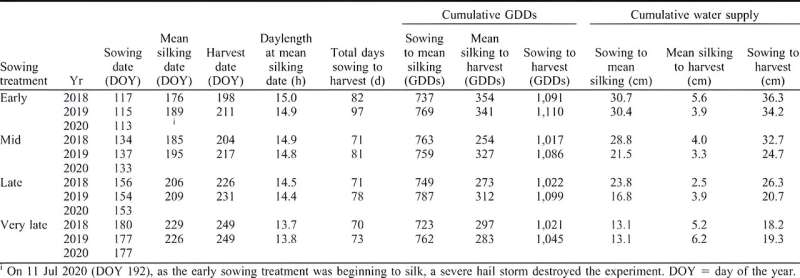This article has been reviewed according to Science X's editorial process and policies. Editors have highlighted the following attributes while ensuring the content's credibility:
fact-checked
peer-reviewed publication
trusted source
proofread
Study: No evidence sowing date influences optimum plant density of sweet corn grown in the midwestern US

Sweet corn (Zea mays L.var. rugosa or saccharata) is sown across a wide range of dates to provide a steady supply of marketable ears for fresh market and processing. Because the product is perishable, marketable ears must be harvested in a timely manner. A steady supply of marketable ears is important for both the fresh market to maximize sales period and the processing market because processing facilities have a finite capacity to handle incoming perishable ears.
To create a long harvest window during the growing season, the sweet corn industry staggers the sowing dates and, to a lesser extent, uses early-maturing hybrids at the onset of the growing season. In the midwestern United States, the sowing window ranges from early April to early July, resulting in a harvest window from early July to early October.
Across this sowing window, certain environmental conditions change predictably, including shortening day length at silking. Nonetheless, sweet corn development during this research was driven by thermal time. Because later sowing dates accumulate heat units more rapidly during vegetative growth, days to silking and maturity decrease across the sowing window. This research was conducted to empirically quantify the extent to which the sowing date influences the crop growth response to the plant density, optimum plant densities, and maximum profit to the processor and yield to the grower.
Few interactions were observed between sowing date and plant density on crop growth responses. Plant height after silking was unaffected by plant density until the latest sowing date. For the very late sowing date, plant height was shortened at a rate of ∼2.1 cm for each additional plant/m2. Otherwise, plant height was relatively consistent across other sowing dates and plant densities.
The sowing date had no effect on the optimum plant density or whether the plant density was optimized for profit to the processor or yield to the grower. Although there appeared to be a slight decrease in optimal plant densities across some sowing dates, these trends were not significant.
Using field experiments, the objectives of this research were to quantify the effect of the sowing date on growth responses to plant density and determine the extent to which the sowing date influences the optimum plant density and maximum yield/profit. There were few main effects or interactions of the sowing date on crop growth.
More importantly, there was no effect of the sowing date on the economically optimum plant density or plant density that optimized yield. Although variations exist in sweet corn optimum plant densities in the midwestern United States, these variations are likely driven by several factors other than the sowing date that have not yet been fully characterized.
The findings are published in the journal HortScience.
Dr. Williams, the lead author, is an ecologist with the United States Department of Agriculture in Urbana, Illinois. He helps growers sustainably produce affordable and nutritious vegetables for consumers, explains critical problems in weed management and crop production, and delivers solutions to the vegetable seed and processing industries in the U.S. and beyond.
More information: Martin M. Williams et al, No Evidence Sowing Date Influences Optimum Plant Density of Sweet Corn Grown in the Midwestern United States, HortScience (2023). DOI: 10.21273/HORTSCI16933-22
Journal information: HortScience
Provided by American Society for Horticultural Science





















